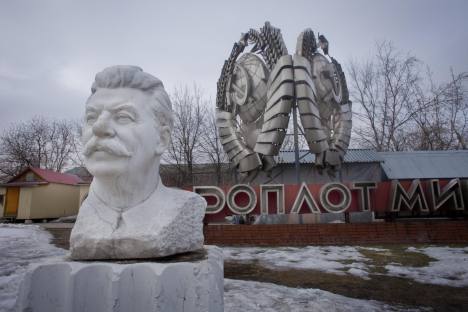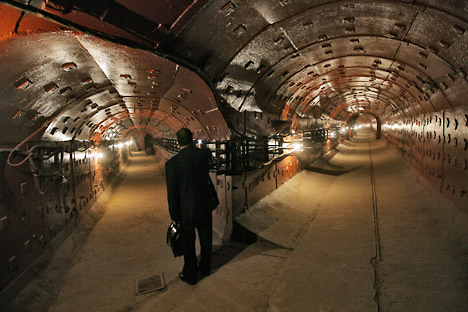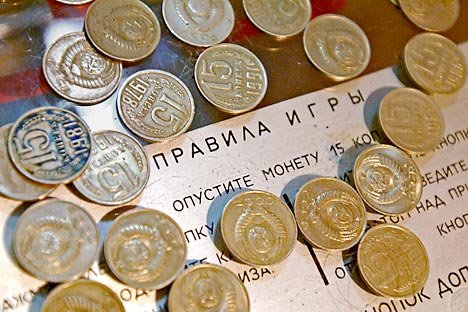
Hard man: a bust of Stalin in the sculpture park at the Museon on Krymsky Val, which also includes six statues of Lenin and one of Sverdlov. Source: Ricardo Marquina Montanana
The days of Soviet Communism are long gone
but reminders of the era are all around Moscow,
ensuring it will never be forgotten.
Not even the thick morning fog that
covers Moscow
can hide the Stalinist spires of the Seven Sisters wedding-cake skyscrapers.
They are an ever-present, looming reminder of Stalin. The buildings were seen
as symbols of a new era, emblems of the triumph of a resurgent country
proclaiming its greatness to the world.
Even a trip on the Moscow Metro transports passengers back in time to the days
when stations, like Komsomolskaya, were built as palaces for the proletariat.
Many of the relics from the days of the USSR are now museum pieces. Statues of prominent Communists that once stood in the city’s central squares were removed after the events of August 1991 which marked the end of Communism. They have since found refuge in the sculpture park at the Museon on Krymsky Val. Among the 700-odd sculptures carved in stone, wood, bronze, and other materials stand six versions of Lenin, a grim Stalin with a chipped nose and a suspiciously athletic Sverdlov (a Bolshevik party leader) peering out eerily in the garden’s snow-white mist.
The statue of Felix Dzerzhinsky or “Iron Felix” (the first leader of the secret police) was removed from the museum and placed back in Dzerzhinsky Square several times before finally accepting its fate in the park.
The square, which has now reclaimed its original name of Lubyanka Square, is
the home of the KGB building which now houses the FSB museum (often referred to
as the KGB museum), which opened in 1989. Among its visitors at various times
were former CIA chiefs Stansfield Turner and William Webster, as well as
representatives of major intelligence services across the world. The museum,
which is open by
appointment
only at certain times of the year, tells the hidden history of the country, starting from the
first Russian counter-intelligence against Tatar Mongol invaders up to recently
declassified documents concerning the capture of agents and joint work with
foreign intelligence services.
The model explosive devices and cameras built into beer cans and cigarette packs make you look around anxiously. Among the exhibits are two suitcases in which a Japanese official failed to smuggle women.
Bunker-42
Stalin’s bunker, or Bunker-42, is 65 metres (200ft) underground (Building 11,
Fifth Kotelnichesky Lane). Hidden from sight in the heart of the capital, it
was guarded round-the-clock by up to 600 officers for nearly 30 years.
In the Sixties, Bunker-42 was fully equipped with everything necessary to survive a nuclear attack. Now, it is all on display as part of the Central Museum of Armed Forces. Walk through secret tunnels, see Red Army weapons and communications equipment, as well as the renovated conference room for the leadership and Stalin’s study.

Stalin’s bunker, or Bunker-42. Source: Kommersant
Holiday camps
Many Russians remember going on Young Pioneer holiday camps at Black Sea
resorts when they were children. And a trip to the Museum of Soviet Arcade
Machines (11 Baumanskaya St) will bring those childhood memories flooding back.
Organised by three enthusiasts who have scoured the country for broken gaming
machines to restore, the museum has three modest rooms packed with them. They
include mini skittles and a shaibu-shaibu ice hockey game (named after the
traditional chant of fans), and the collection is growing. Visitors can
exchange their roubles to play the games. For three Soviet kopecks – about 30
roubles (60p) – you can get a syrupy soda pop from the ancient vending machine
at the museum entrance.
The old arcade machines were originally assembled at munitions factories and they were remarkably expensive, costing from 2,500 to 4,000 roubles – almost the price of a Zhiguli car.

The Museum of Soviet Arcade Machines. Source: ITAR-TASS
A taste of Soviet life
You don’t have to go far in Moscow in search of Soviet-era food. It is sold on
the ground floor of the GUM department store (3 Red Square), or you can visit
the eateries on its third floor – Festivalnioye Café and Dining Room 57. There
are many pseudo-Soviet caf é s in the historic centre of Moscow, as well as
more authentic establishments that serve pelmeni (dumplings) and shots of
vodka. Start the day with a Soviet breakfast of semolina porridge, which was
the staple breakfast for all children in the USSR. The Children of Paradise caf
é (25 Nikitsky Boulevard) has a Soviet menu offering 10 types of stewed fruit,
soups and lump-free semolina porridge.
“Down with kitchen slavery”, reads a poster showing a rebellious housewife that
hangs at the entrance to the Soviet-era cheburechnaya – a place that sells meat
pasties (50 Pokrovka St). And, sure enough, the cooks and waiters are all
male.
Here you’ll taste Moscow’s best chebureki (meat pasty) stuffed with brynza (feta-like cheese). Wash it down with a Zhiguli beer or a soda available in every colour from green to purple. For added atmosphere, valve radios play Soviet songs, posters with pronouncements by Soviet leaders adorn the walls and smoking is allowed everywhere.
Source: Ricardo Marquina, ITAR-TASS
The building of the former Automotive Transport Ministry now houses GlavPivTorg
(5 Bolshaya Lubyanka St), a restaurant that replicates Soviet-era ministerial
dining rooms. The interior has baize-covered ministerial desks, a red carpet
and a library.
The Annushka tram restaurant, which was named after the protagonist of Mikhail Bulgakov’s celebrated novel The Master and Margarita , banned under Stalin, is another phantom of the Soviet era. The restaurant shuttles through Moscow’s historic centre, offering a choice of three routes. Board near the Chistye Prudy Metro station.
All rights reserved by Rossiyskaya Gazeta.
Subscribe
to our newsletter!
Get the week's best stories straight to your inbox